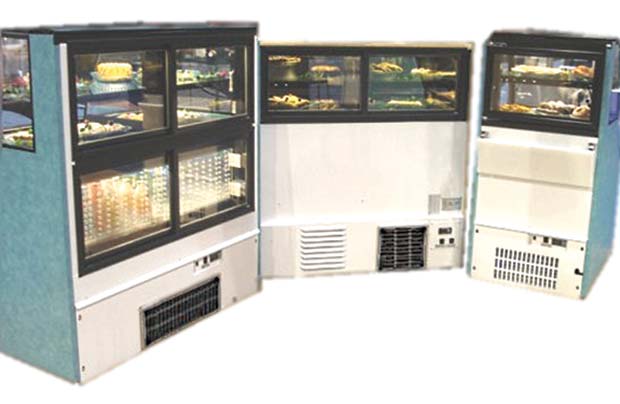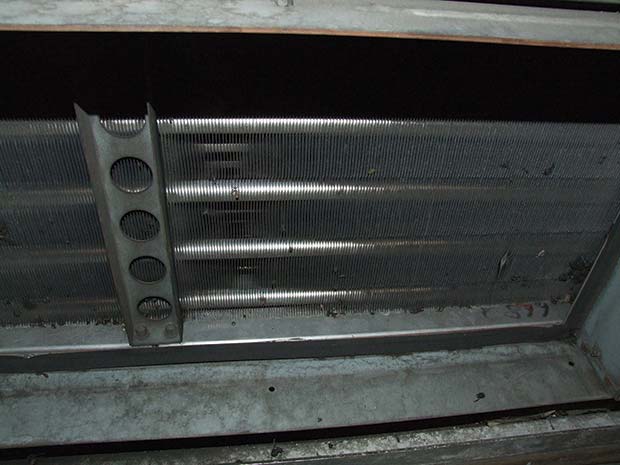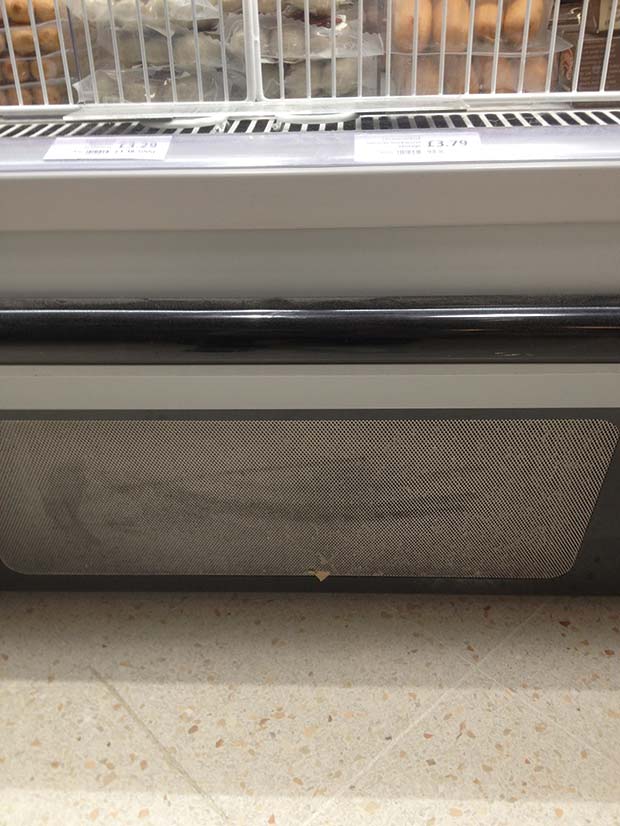The next time you look at your integral display unit, think about how many times you have to call the maintenance engineers to clean and repair these refrigerated displays. Richard Betts, managing director of RAB Specialist Engineers offers retail managers some advice on how certain low-cost energy efficiency measures can prolong the life of refrigeration equipment, avoid lost stock, reduce maintenance costs and lower energy usage.

One of the major causes of refrigerator inefficiency or failure is dirty or clogged condenser coils. This results in restricted airflow throughout the system and will require the refrigerators to work harder and consume more electricity in order to maintain the optimum temperatures necessary to avoid food spoilage.
Retail energy
It’s not just the smaller sized high-street chains of coffee and sandwich shops that are affected by refrigeration inefficiencies. Research from the Journal of Applied Thermal Engineering suggests that the UK’s retail food outlets are responsible for approximately 3% of total electrical energy consumption. Refrigeration accounts for a major percentage of in-store electricity demand ranging from 25% – 30% for larger hypermarkets to over 60% for food-dominant convenience stores. The report concludes that if those stores with above average energy usage reduced their consumption to industry-wide average levels through implementing energy conservation measures, then an additional 10% electrical energy savings could be achieved. This represents around 840 GWh of electricity and a reduction of 355,000 tonnes of CO2 emissions if applied to all the stores of the major retail food chains in the UK.
Carbon Trust reports that refrigerated display cabinets are estimated to use a minimum of 5,800 GWh of energy each year. At current values, and with spiraling energy costs, this is expected to exceed £754m per year and will create a significant drain on the UK’s energy resources at a time when capacity margins are shrinking and warnings of energy blackouts could become a reality during winter 2014.
Government taskforce
In June 2013, during the annual Consumer Goods Forum (CGF) Refrigeration Summit in London, Climate Change Minister Greg Barker called on the UK’s major supermarkets to address the pressing issue of using costly, ozone-depleting chlorofluorocarbon (CFC) refrigerants. He urged the industry to step up its efforts to improve energy efficiency by adopting new refrigeration technologies. To help the industry in its efforts, a taskforce was set up to help unlock further potential energy savings in the retail sector.

Cleaning regime
One of the quickest and simplest ways to improve energy efficiency and reduce energy consumption is to ensure a regular maintenance schedule for refrigerated display cabinets is carried out. It’s essential for condensers and evaporators to be kept clean and to ensure fans and defrost systems are working correctly.
Further guidance from the Carbon Trust suggests that poor maintenance can increase condensing temperature or reduce evaporating temperature by several degrees, resulting in up to a 10% increase in energy use.
The guidance also stresses the importance of avoiding any build up of dirt or debris on the air-intake components. Irregular cleaning schedules can potentially damage a refrigeration unit, resulting in downtime, loss of business and a hefty repair bill. In short, regularly cleaning condenser coils will maintain compressor efficiency, saving energy and money.
Specialist maintenance firms will provide regular cleaning schedules but these can be expensive, particularly when a typical condenser may cost anything from £100 to £500 to clean.

Refrigerated display units have a system containing a compressor, evaporator and condenser fans. This allows ease of maintenance and repair within limited and valuable floor space. These critical components and air intake fins are usually located at foot traffic level and are prone to clogging from airborne debris and dirt.
Perhaps one of the quickest, cheapest but often described as the most underexplored way of saving energy is from a thorough examination of the hydronic coils. Cooling cools within refrigerated displays are designed with tight fin spaces and as such will often act as air filters, trapping particulate and biological masses. In addition to foul odour emittance, the blocked fins will impede airflow, causing the compressors to work harder and therefore use more energy.
In a typical supermarket the cost of refrigeration is by far and away the largest percentage of energy used and the retail display units are a 24/7 operation with high failure rates. These failures often have nothing to do with the quality of the equipment but are caused by a poor cleaning regime resulting in fan overload. If a coil fin is allowed to become dirty, this in effect creates an insulating blanket of airborne debris across the airways. In the event of a failure a retail outlet will lose product, revenue from lost sales and have to deal with a potentially expensive repair bill. This will not only have a short-term impact on profit, but may also lead to long-term damage to a store’s reputation.
To avoid expensive maintenance schedules and prolong the life of sensitive refrigeration equipment, many retail outlets are recognising the benefits of using external air intake filters. This allows regular retail staff to remove and clean them as part of their daily cleaning schedule. Air intake screens, such as the type fitted by RAB Specialist Engineers, can be positioned on the outside of metal air intake louvres thanks to a unique magnetic fixing design. The filters then become easily accessible from the outside without having to pay engineers to have displays turned off and dismantled in order to retrieve them.
 There are approximately 800,000 retail display units running in the UK with more being added everyday as the number of convenience stores grow. Larger stores also have industrial chillers all of which are suffering from coil clogging. In every survey completed by RAB Specialist Engineers the only time a genuinely clean coil appears is just after an engineer packs away his tools. As soon as the power is turned on, the fans draw more dirt in. With ROI of less than a single cooling season, there is a great opportunity for retail managers to reduce energy bills substantially.
There are approximately 800,000 retail display units running in the UK with more being added everyday as the number of convenience stores grow. Larger stores also have industrial chillers all of which are suffering from coil clogging. In every survey completed by RAB Specialist Engineers the only time a genuinely clean coil appears is just after an engineer packs away his tools. As soon as the power is turned on, the fans draw more dirt in. With ROI of less than a single cooling season, there is a great opportunity for retail managers to reduce energy bills substantially.
Starbucks saves big bucks
In the US, Starbucks Coffee has installed energy efficient, self-contained, refrigerated, grab-and-go deli/pastry display cases throughout its stores. The refrigeration systems are designed to display food products at eye level, within easy reach, and house critical refrigeration components inside the base of each unit.
Located at foot level, the refrigeration components and air intake fans were prone to dirt and dust brought in to the stores by customers. William Miko, the regional facilities manager for Starbucks’ metro New York found that clogged refrigeration coils were causing display temperatures to rise throughout his 300 busy stores. Without frequent cleaning, the clogged coils were causing costly compressor failures that led to loss of sales. Starbucks installed the air intake filter screens, manufactured by Permatron, as part of its preventative maintenance programme.
Technicians from Starbucks discovered that the display units were running more efficiently and so much colder, that they were able to adjust the refrigeration so that it consumed less energy. The air intake filter screens have proved so effective that Starbucks is now installing them on its ice-making machines.
UK trials
Having heard about the benefits, several other food and drink outlets closer to home are now trialling the filters across their stores. Soho Coffee Co. is an independent, privately owned, Fairtrade business with 24 stores throughout the UK. The company prides itself on its green credentials and is working on several initiatives with its partners to lower its carbon footprint. Reducing energy consumption is one of its goals and so the company is currently trialling air intake filter screens in Cheltenham and Bristol.

Commenting on the trials Pete Manuel, property director for Soho Coffee Co. said: “We run large display cabinets in busy thoroughfares in shopping centres, all of which take a real hammering from dust ingress. We are trialling these filters in our Cheltenham and Bristol stores to prevent the chiller mechanisms being over loaded with dust, consequently causing high ticket repairs and excessive energy use.
Initial indicators show that these air intake filter screens are proving to be very effective in separating nearly all dust from whirling into the chiller components. An additional benefit is that team members are able to remove these filters completely, allowing the dust and dirt be easily cleaned off away from selling areas and customer traffic.”
With energy prices rising and businesses forced to make savings, retail managers from smaller high-street outlets through to major UK supermarket chains are looking at innovative ways to make cuts and reduce energy consumption. While regular maintenance schedules are essential for keeping equipment running efficiently, steps can be taken to reduce these costly regimes that may involve shutting down refrigeration equipment or carrying out expensive repairs during trading hours.
Fitting external air intake filter screens will allow essential cleaning to take place without incurring the costs of specialist refrigeration firms. Clogging of air intake vents caused by outside debris can be avoided and help extend the life of sensitive refrigeration equipment. In addition, air intake screens can extend the life, and reduce the replacement cost of filters fitted to air handling equipment. In certain applications, replacing a standard G4 filter with an R2 Prevent Screen will increase particle capture and improve airflow. This allows motor speeds to be reduced and significant energy savings to be achieved. Typical results from a 20% reduction in speed will offer a 50% reduction in energy.
 For more information about how air intake filters are being used by the UK’s food retail industry, visit www.rabse.com.
For more information about how air intake filters are being used by the UK’s food retail industry, visit www.rabse.com.





Comments are closed.